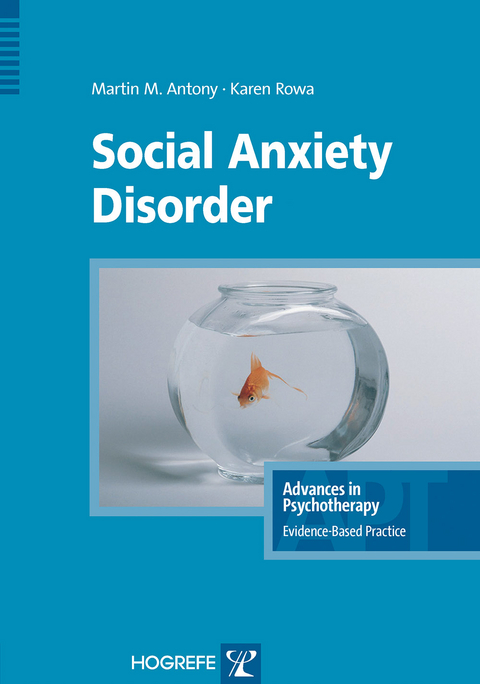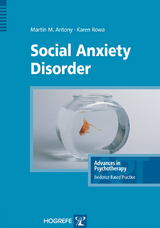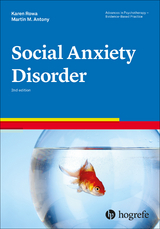Social Anxiety Disorder
Hogrefe & Huber (Verlag)
978-0-88937-311-2 (ISBN)
- Titel erscheint in neuer Auflage
- Artikel merken
Social anxiety is characterized by excessive anxiety or discomfort in situations where a person might feel judged or evaluated by others, including performance situations (e.g., being the center of attention, public speaking, working under observation, playing sports or music in front of an audience) and situations involving interpersonal contact with others (e.g., making small talk, meeting new people, dating). According to large-scale epidemiological studies, social phobia is one of the most prevalent psychological disorders. Although prevalence estimates vary, recent studies suggest that approximately 7 per cent of Americans suffer from this disorder. In addition to the high percentage of people with symptoms meeting criteria for this disorder, many other individuals experience social anxiety or shyness to a lesser, but still impairing degree. Social phobia is also a common comorbid condition, often diagnosed along with other anxiety disorders.Taken together, this information suggests that practitioners are likely to encounter patients displaying some degree of social anxiety, no matter what specialty service or setting they occupy.
Although social anxiety is a widely encountered problem, there are few resources available to provide straightforward, accessible assessment and treatment information for practitioners. This book aims to fill that gap. Over the past 20 years, effective tools have been developed to identify and treat individuals with social anxiety. The current book provides up-to-date information on the diagnosis, identification, conceptualization, and treatment of social anxiety and social phobia.This book is aimed at practitioners who practice in a broad range of settings, from specialty clinics to general practice, as well as students. Existing books tend to focus on the psychopathology of social anxiety, address multiple disorders in one volume, or provide extensive and detailed protocols for treating this disorder. In contrast, this book is a more concise guide to identification and treatment that is accessible for the busy practitioner. It focuses specifically on social phobia and social anxiety, making it an attractive reference book for professionals who require clear, easy to follow guidelines on treatments for social anxiety.
Preface * Dedication; 1 Description; 1.1 Terminology; 1.2 Definition; 1.3 Epidemiology; 1.4 Course and Prognosis; 1.5 Differential Diagnosis: Panic Disorder with Agoraphobia * Generalized Anxiety Disorder * Specific Phobia * Depression * Avoidant Personality Disorder * Schizoid Personality Disorder; 1.6 Comorbidity; 1.7 Diagnostic Procedures and Documentation: Interviewer Administered Measures * Self-Report Severity Measures * Behavioral Approach Tests (BATs) * Assessing Suitability for Treatment; 2 Psychological Approaches to Understanding Social Anxiety Disorder; 2.1 Clark and Wells' Cognitive Model; 2.2 Rapee and Heimberg's Cognitive Behavioral Model; 2.3 Negative Learning Experiences and Social Anxiety; 2.4 Temperamental Bases of Social Anxiety Disorder; 2.5 Implications for Treatment; 3 Diagnosis and Treatment Indications; 3.1 Key Features to be Assessed: Situational Triggers * Physical Features * Cognitive Features * Avoidance Strategies * Safety Behaviors * Anxiety Sensitivity * Social Skills * Environmental Factors * Comorbidity * Functional Impairment; 3.2 Overview of Effective Treatment Strategies; 3.3 Factors That Influence Treatment Decisions: Age, Sex, and Ethnicity * Education * Family and Relationship Factors * Client Preference * Treatment History * Ability to Articulate Cognitions * Anxiety Sensitivity and Fear of Sensations * Severity of Avoidance and Safety Behaviors * Social Skills * Comorbidity * Group vs. Individual Treatment; 4 Treatment; 4.1 Methods of CBT: Self-Monitoring * Psychoeducation * Cognitive Strategies * Exposure-Based Strategies * Social Skills Training * Relaxation and Arousal Management Strategies; 4.2 Mechanisms of Action: Cognitive Models * Behavioral Models * Emotional Processing Models; 4.3 Efficacy: Efficacy of CBT * Predictors of Outcome * Preventing Relapse and Return of Symptoms; 4.4 Combination Treatments: Medication Treatments * Comparing and Combining Medications and CBT; 4.5 Overcoming Barriers to Treatment: Treatment Ambivalence * Homework Noncompliance * Adapting Treatment for Comorbidity; 4.6 Adapting Treatment for Different Age Groups; 4.7 Adapting Treatment for Different Cultures; 5 Case Vignettes; 6 Further Reading; 7 References; 8 Appendix: Tools and Resources.
| Erscheint lt. Verlag | 1.2.2008 |
|---|---|
| Reihe/Serie | Advances in Psychotherapy - Evidence-Based Practice ; 12 |
| Zusatzinfo | 15 tables, 2 figures |
| Verlagsort | Toronto |
| Sprache | englisch |
| Maße | 178 x 254 mm |
| Themenwelt | Geisteswissenschaften ► Psychologie ► Klinische Psychologie |
| Medizin / Pharmazie ► Medizinische Fachgebiete ► Psychiatrie / Psychotherapie | |
| ISBN-10 | 0-88937-311-6 / 0889373116 |
| ISBN-13 | 978-0-88937-311-2 / 9780889373112 |
| Zustand | Neuware |
| Informationen gemäß Produktsicherheitsverordnung (GPSR) | |
| Haben Sie eine Frage zum Produkt? |
aus dem Bereich





